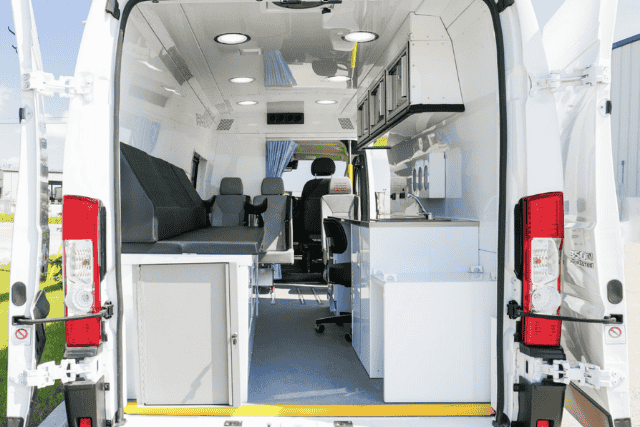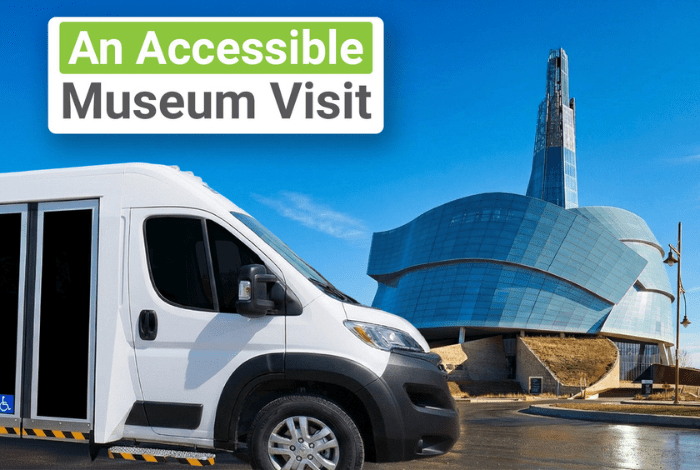Are mobile medical buses the best choice for your mobile healthcare program? On paper, they seem like a solid option. But once you start digging into the details, you might find they’re not the easiest fit.
Maybe you’re providing mobile healthcare to rural communities in northern Manitoba, or running outreach in downtown Vancouver. You’re likely searching for a mobile medical bus for sale that can bring care where it’s needed.
But then the practical stuff kicks in:
- Can it get down gravel roads in rural areas or park in tight city lots?
- Will your team need a special license to drive it?
- What will long-term upkeep look like?
These aren’t small questions. And if they’re making you second-guess your choice, you’re not alone. Many organizations across Canada have been in the same spot, trying to find a solution that fits real-world challenges.
MoveMobility has over 20 years of experience building mobile medical units that reduce barriers to care. Our vehicles have the National Safety Mark, along with Ford QVM and Stellantis QPro certifications. We’ve worked with teams like yours and Quest Community Health Centre across Canada, and while we don’t build buses, we’re here to help you make an informed choice.
In this article, you’ll learn:
- 5 reasons we don’t manufacture mobile medical buses
- Alternatives that may suit your program better
5 reasons MoveMobility doesn’t manufacture mobile medical buses

There’s a time and place for mobile medical buses, but for many Canadian programs, they’re not the most practical fit. We’ve worked with teams from coast to coast who were exploring buses but shifted gears once they realized the gaps these large vehicles can create. Let’s break down the biggest reasons we don’t manufacture them, starting with the one you’ll run into first: Size.
1. They’re often too big for where you need to go
Mobile medical buses are large. That might sound like a good thing at first. But when you’re trying to deliver care in the real world, their size can work against you.
Imagine this: You’re bringing care to a northern Indigenous community in Ontario. The roads are winding, narrow, maybe even gravel. Now picture trying to steer a full-size medical bus through that. Add some snow, mud, or spring runoff, and things get messy fast.
Now think urban: You’re parked on a side street in downtown Montreal, or trying to turn into a lot in East Vancouver. Good luck squeezing in a 40-foot bus.
Here’s what makes their size tricky:
- Tight spaces: Limited parking and narrow roads aren’t bus-friendly
- Driver restrictions: Larger buses often need a commercial driver’s license
- Added costs: Training, licensing, and insurance all go up
- Fewer options: Smaller teams might not have staff qualified to drive big vehicles
Mobile healthcare is about where your team needs to go. And most of the time, that includes rural backroads, busy downtowns, and everywhere in between.
Other vehicle options often give you more freedom. You can focus on reaching people, not on maneuvering a giant vehicle around obstacles.
2. Mobile medical buses cost way more than most programs can handle
Mobile medical buses don’t come cheap. In fact, they can cost two to three times more than other types of mobile medical units. That kind of price tag can eat up your entire budget before you’ve even hired staff or stocked supplies.
Unless you’re a large hospital network or a heavily funded government agency, that kind of spending just doesn’t make sense.
Let’s break it down:
- Upfront cost: A fully outfitted mobile medical bus can cost upwards of $500,000 to $700,000 CAD, or more, depending on the features
- Customization costs: More space means more outfitting—think cabinetry, medical equipment, plumbing, and power systems
- Operating costs: Fuel, insurance, and maintenance are all more expensive than van-based units
- Repair downtime: Bigger vehicles often require specialty mechanics and longer repair times
Now compare that to a van-based unit or shuttle-style mobile clinic: The cost of a mobile medical van ranges from $205,000 to $315,000 depending on your setup. They’re easier to service, cost less to run, and still offer everything you need for most community health programs.
For many nonprofits, Indigenous health teams, or regional health authorities, mobile medical buses end up being out of reach. And if you do manage to stretch the budget for one, you may have little left over for staffing, fuel, or outreach.
Sometimes, it’s not about having the biggest vehicle. It’s about getting the right one—so your program can grow, stay active, and actually reach the people who need you.
3. They come with more maintenance and more downtime
Mobile medical buses require a lot of upkeep. These vehicles are essentially rolling buildings with complex systems packed inside. That means more things that need regular checks, repairs, and sometimes complete overhauls.
Here’s why maintenance can become a full-time job:
- Complex equipment: Most buses include sinks, toilets, lifts, HVAC systems, generators, and more. All of these need regular servicing to stay safe and functional
- Commercial-grade systems: Buses use heavy-duty engines, transmissions, and air brakes. These systems wear differently than standard vehicles and often need specialized technicians
- Fewer repair options: Not every service shop can take in a full-size bus. Many rural or remote areas don’t have garages with tall bays or heavy-lift tools
- Parts delays: Sourcing parts for a commercial bus can take longer, especially if it’s a specific make or older model
- Extra wear and tear: The weight of a bus puts more strain on suspension, tires, and steering, leading to more frequent maintenance
The more time your vehicle spends in the shop, the less time it’s helping people. And when you’re running a tight schedule and trying to meet growing community needs, frequent downtime can derail everything.
Ongoing maintenance is a big part of owning any mobile medical unit, but with a bus, it becomes a bigger, costlier, and more time-consuming responsibility.
4. They require commercial driver’s licences
You can’t just hand the keys to anyone. Mobile medical buses are heavy, and in most provinces, that means your drivers need a commercial licence. For many programs, this adds a layer of complexity that’s easy to overlook.
Here’s how it works in Canada:
- Any vehicle over 11,000 kg (about 24,250 lbs) typically requires a Class D or equivalent commercial licence
- Mobile medical buses often weigh between 13,000 and 18,000 kg once fully outfitted with equipment, supplies, and power systems
- Each province has its own rules, but most follow similar thresholds when it comes to weight-based licensing
So what does this mean for your team?
- Fewer qualified drivers: Not everyone has a commercial licence, and getting one takes time, training, and testing
- Added costs: Licensing programs, driver training, and insurance premiums all go up
- Scheduling challenges: You’ll need to plan around driver availability, which can slow down your ability to respond quickly to community needs
Driving a mobile medical bus isn’t the same as driving a regular vehicle. If your team doesn’t already have commercial drivers on staff, this can become a big hurdle, especially if your services run daily or cover wide regions.
When you’re focused on healthcare delivery, the last thing you want is to be held back by red tape and driver shortages.
5. They’re harder to deploy in emergency or short-notice situations
Mobile medical buses take more time and planning to get on the road. That’s a challenge when your program needs to be responsive, especially during emergencies or pop-up clinics.
If your team provides seasonal outreach, covers wildfire evacuation zones, or supports public health crises like flu or COVID-19 outbreaks, getting services out fast matters. A mobile medical bus often slows things down.
Here’s why:
- Longer warm-up times: Larger onboard systems like generators and HVAC units take longer to power up and stabilize
- More setup logistics: You may need traffic control, multiple staff members, and special parking arrangements
- Route restrictions: Road bans, weight limits, and bridge clearances can limit where and how fast you can deploy
- Longer prep windows: Loading, cleaning, restocking, and travel all take more time than with smaller units
Speed can mean the difference between life and death in high-pressure medical situations. If your response is delayed because your bus takes hours to prepare or can’t reach the site, your community might miss out on the care they need when they need it.
Even for scheduled services, the ability to move quickly and efficiently gives your team more reach, more coverage, and more consistency. With mobile medical buses, that kind of agility becomes a lot harder to maintain.
What alternative mobile medical units does MoveMobility use?
At MoveMobility, we focus strictly on building mobile medical units using van chassis like the Ram ProMaster and Ford Transit. We’ve tested a lot of vehicle platforms over the years, and these are the ones that keep showing up as the best fit for healthcare programs across Canada.
Here’s why we’ve made vans our go-to choice:
- They go (almost) anywhere: These vans are compact and nimble. That means you can drive them through narrow backroads in Nunavut or slip into a tight parking spot in downtown Halifax. You don’t need to worry about low clearances, sharp turns, or complicated parking logistics
- They’re cost-effective: As mentioned earlier, a mobile medical bus can cost anywhere from $500,000 to $700,000. Depending on features, van-based medical units often range between $160,000 to $250,000. That leaves more room in your budget for staff, equipment, and outreach
- Less maintenance hassle: With fewer complex systems and widely available parts, van maintenance is easier and cheaper. You’re not stuck waiting weeks for a specialty shop to get the right lift or component
- No commercial licence needed: These vans stay under the 11,000 kg limit, so a standard Class G licence is all most drivers need. That gives your team more flexibility and fewer scheduling issues
- Fast deployment: Setup takes less than 15 minutes. That means you can arrive, park, power up, and start providing care without a big checklist or long delays
We build vehicles that match your goals and your terrain. Vans give you the freedom to respond quickly, serve more locations, and keep things running smoothly.
Got any questions about mobile medical buses?
You came to this article trying to figure out if mobile medical buses are the right choice for your healthcare program. Maybe you’re building something from scratch or looking to expand an existing outreach effort. But somewhere along the way, you started wondering if a massive bus is really the most practical option for the places you serve and the people you support.
Here’s what you learned today:
- They’re big: Not ideal for tight rural roads or urban lots
- They’re pricey: Often 2–3 times more than other units
- They’re complex: More maintenance, more parts, more downtime
- They’re restricted: You need commercial drivers and can’t pivot easily
- They’re slow to deploy: Not great for urgent or flexible outreach
MoveMobility has helped hundreds of Canadian organizations turn mobile care into a reality. We’ve worked with First Nations health teams, non-profits, municipalities, and healthcare networks across the country to build vehicles that go where you go and do what you need.
From day one, we design with your patients and your program in mind. No guesswork, no cookie-cutter builds, just real-world solutions that remove barriers and help save lives. If you’re still unsure about what vehicle is right for your program, click the button below to talk to a real human. We’re here to help.
If you’re not ready to talk to a mobility expert yet, we’ve got a few more resources that can guide you forward:
- What mobile medical equipment can be installed in mobile clinics?:This article will give you a better idea of what types of mobile medical equipment you can get in your mobile clinic.
- Mobile medical RV vs. mobile medical van: You might also be interested in comparing mobile medical RVs to vans. Read this to learn more.





